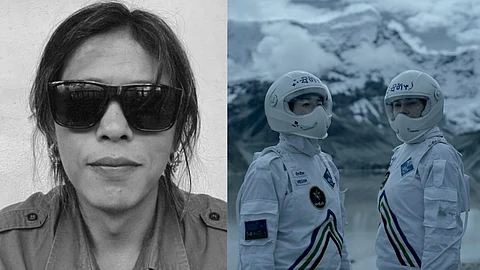
- HOMEGROWN WORLD
- #HGCREATORS
- #HGEXPLORE
- #HGVOICES
- #HGSHOP
- CAREERS
- ABOUT US
- CONTACT US

The term ‘Adivasi Futurism’ was coined by artist and scholar Rajni Perera in 2018. Lately, more and more South Asian artists are exploring the potential of this genre. Adivasi Futurism is a contemporary art movement that blends the traditional and modern culture of the Adivasi (Indigenous) communities of India with elements of science fiction, fantasy, and futuristic themes. It is an expression of the Adivasi people's cultural identity and their aspirations for the future. It seeks to challenge dominant narratives and reimagine Adivasi identity in a way that is both rooted in tradition and forward-looking. Some examples of Adivasi Futurist art include depictions of Adivasi people in futuristic settings, the use of traditional Adivasi symbols and motifs in a sci-fi context, and the blending of Adivasi oral histories with science fiction narratives.
One particular artist from eastern Nepal who has been doing some fascinating work in the realm of Adivasi futurism is Subash Thebe Limbu. Although primarily a painter, around late 2015 and early 2016, during the second year of his MFA, Limbu started experimenting with sound, music, and performances surrounding this movement. He used previously recorded sound clippings of protests and the sounds of him reading passages from Octavia E. Butler’s works.
Octavia Butler’s work was crucial to laying down the foundation for Limbu’s art. He quickly realized how Butler’s stories were different from the laser-toting spaceships and space wars of mainstream science fiction. Her writing contained a futuristic world imagined by a person of color, which was inspirational for Limbu in developing his own creative practice. Storytelling, indigeneity in futuristic timelines, and science fiction — Limbu was trying to incorporate all of this into his practice. Through it, he found a renewed appreciation for Afro-Futurism, to which he greatly owes for his current practice of Adivasi Futurism.
Limbu believes that he enriches his own practice by paying tribute to Afro-Futurism and Indigenous Futurism, genres that were born out of North America. Most indigenous people in the world, including the Nepali artist, share a similar history of oppression, dispossession, colonization, and marginalization but indigeneity does not exist as a monolith. The word ‘Adivasi’ is a Nepali word for ‘indigenous’ and is also synonymously used as a collective term for all indigenous communities in the Indian subcontinent. For Limbu, Adivasi Futurism is a space where Adivasi artists can exercise their agency, indigenous knowledge, and creativity without overlapping with the predominant Brahminical, patriarchal, or casteist mainstream narratives that have been pernicious to the Adivasis, Dalits, Madhesis, women and queer people in his homeland.
Incorporating science fiction through an indigenous lens has been a hallmark of Limbu’s digital and sound artworks. With the use of indigenous scripts, songs, and symbols, he has brought to life a mothership design, inspired by Silamsakma, a ritualistic object that symbolizes identity among the indigenous Yakthung nationalities in Nepal. In Limbu’s works, you will find references such as indigenous astronauts and time-travelers, spaceships called Ingsums, and many such stories in a future timeline inspired by indigenous oral history. The setting of most of his works is between the Yakthung nation and the Khambu nation, where the artist hails from.
His latest project, a film called 'Ningwasum' is a Yakthung science fiction documentary film/video work narrated by Miksam, a time traveler from a future indigenous nation. The film was mostly shot in Sherpa Nation, Yakthung Nation, and Newa Nation, in what we presently know as Nepal. The film premiered at the 10th Asia Pacific Triennial of Contemporary Art, at the Queensland Art Gallery and Gallery of Modern Art, Brisbane. Apart from that, it was screened at Kathmandu Triennale and is soon to make its premiere in the UK.
As indigenous people are wrongly viewed as an obstacle to progress in today's capitalist neoliberal world, voices like Subash Thebe Limbu's are growing louder. Such indiviudals are challenging the Western idea of 'development.' In these times, Adivasi Futurism can serve as a portal to redefine progress, reject the colonialist narrative of indigenous people as 'primitive,' and envision Adivasi artists as not just storytellers of the past, but creators of interplanetary and interstellar civilizations of the future.
You can follow his work here.
